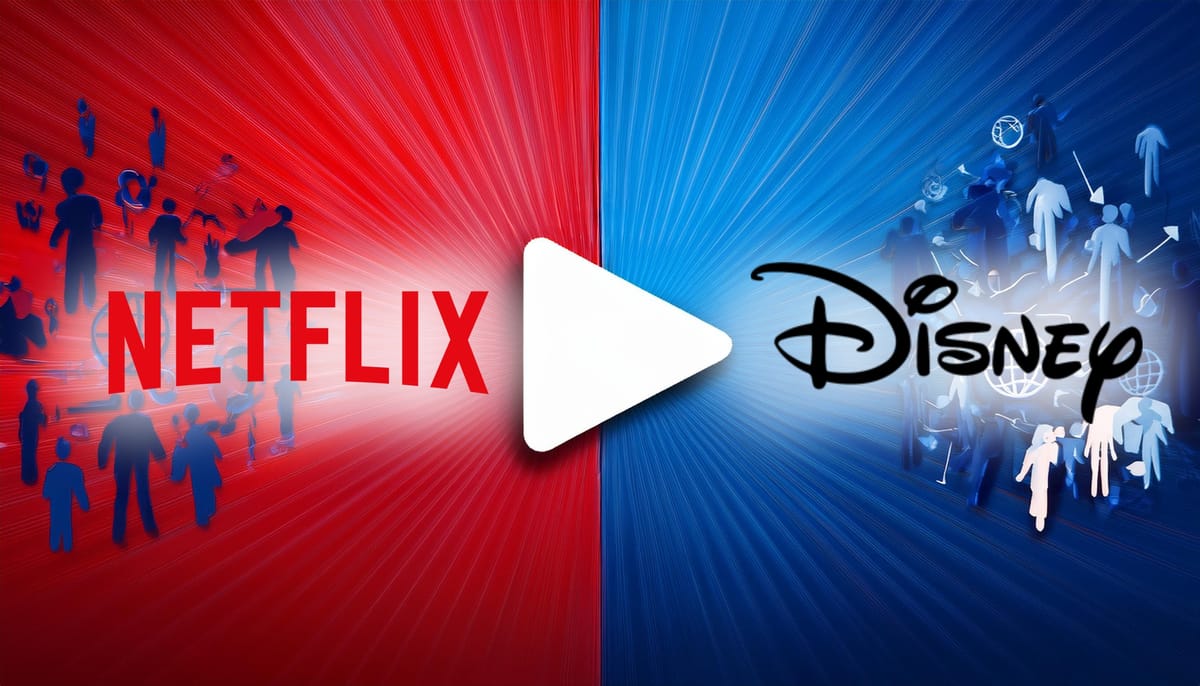In the ever-evolving landscape of digital marketing and the video on demand industry, Netflix stands out as a prime example of a company that has not only disrupted the entertainment world but has also written its own playbook for success in the digital age. From its humble beginnings as a DVD-by-mail service to becoming a global streaming powerhouse, Netflix's journey is a masterclass in adaptation and innovation. This comprehensive analysis delves deep into the strategies that have propelled Netflix to the forefront of the streaming wars and explores how other companies might learn from its approach.
The Evolution of Netflix's Business Model
Netflix's evolution from a DVD rental service to a streaming giant is a testament to its ability to anticipate and adapt to changing consumer behaviors. The company's real genius was in recognizing the potential of streaming technology before it became mainstream, fundamentally altering its business model to stay ahead of the curve.
"We're competing with sleep... We're winning!" - Reed Hastings, Netflix Co-founder and CEO
This quote from Reed Hastings perfectly encapsulates Netflix's ambitious vision. The company isn't just competing with other streaming services; it's vying for a share of people's leisure time. This mindset has driven Netflix to continually innovate and expand its offerings, setting a new standard for the video on demand industry.

From Content Distributor to Content Creator
One of the most significant pivots in Netflix's business strategy was its move into original content production. This shift was not without risks, but it has paid off handsomely. By producing content, Netflix has:
- Reduced its reliance on licensing agreements with other studios
- Differentiated itself from competitors
- Created a loyal fan base for its original series and films
The success of shows like "Stranger Things," "The Crown," and "Bridgerton" demonstrates the power of this strategy. These originals not only attract new users but also keep existing Netflix members engaged, reducing churn and driving subscriber growth.

Leveraging Data Analytics for Decision Making
At the core of Netflix's success is its sophisticated use of data analytics. The company collects and analyzes vast amounts of viewer data to inform decisions on everything from content creation to user interface design. This data-driven approach allows Netflix to:
- Personalize recommendations for individual users
- Predict the potential success of new shows and movies
- Optimize its extensive library for different markets
While other companies in the streaming services sector have access to user data, few utilize it as effectively as Netflix. The company's ability to turn data into actionable insights gives it a significant competitive advantage in the digital marketing landscape.

Netflix's Product Strategy: More Than Just Streaming
When we think of Netflix, streaming is usually the first thing that comes to mind. However, the company's product strategy goes far beyond simply delivering video content over the internet. Let's break down some key elements of Netflix's product approach:
Personalization at Scale
Netflix's recommendation engine is arguably one of its most valuable assets. By analyzing viewing habits, the platform can serve up content that's likely to keep users engaged. This personalization extends to everything from the thumbnails users see to the order in which content is presented.
"We're in a world where people are in quite different situations, and we're able to produce content that satisfies a wide range of situations." - Ted Sarandos, Co-CEO and Chief Content Officer
This quote from Ted Sarandos highlights Netflix's commitment to catering to diverse audiences. The company's vast content library, combined with its sophisticated recommendation system, allows it to serve niche interests while also delivering mainstream hits.
User Experience Innovation
Netflix continually experiments with its user interface and features to enhance the viewing experience. Some notable innovations include:
- The "Skip Intro" button
- Interactive content like "Black Mirror: Bandersnatch"
- The ability to download content for offline viewing
These features may seem small, but they contribute to a seamless and enjoyable user experience that keeps subscribers coming back, setting Netflix apart from traditional linear TV offerings.
Global Content Strategy
Netflix's approach to content has become increasingly global. The company invests heavily in local content production across different international markets, which serves two purposes:
- It appeals to local audiences in those markets
- It provides unique content that can be marketed globally
The success of non-English language shows like "Squid Game" and "Money Heist" on a global scale demonstrates the effectiveness of this strategy, allowing Netflix to compete effectively in new markets.
Technological Advancements Driving Growth
Netflix's technological prowess is a key factor in its ability to deliver a high-quality streaming experience to millions of users simultaneously. The company has made significant investments in its infrastructure and continues to push the boundaries of streaming technology.
Content Delivery Network (CDN)
Netflix operates its own CDN, called Open Connect, which helps deliver content more efficiently to users around the world. This investment in infrastructure allows Netflix to:
- Reduce buffering and improve streaming quality
- Lower its bandwidth costs
- Maintain control over its content delivery
The company's willingness to build its own solutions rather than relying solely on third-party providers has been crucial to its ability to scale efficiently and provide a superior viewing experience compared to linear TV.
Embracing New Formats
Netflix has been at the forefront of adopting new video formats and technologies. The company was an early adopter of 4K and HDR content, and it continues to explore new ways to enhance the viewing experience.
"We're constantly pushing the edge of innovation to surprise and delight our members with amazing picture and sound quality." - Greg Peters, COO and Chief Product Officer
This commitment to quality and innovation helps Netflix maintain its position as a premium streaming service, even as competition intensifies from rivals like HBO Max and other streaming platforms.
Financial Performance and Market Positioning
Netflix's financial performance has been impressive over the past decade, but it's not without its challenges. Let's take a closer look at the company's financial health and market position.
Revenue Growth and Profitability
Netflix has consistently delivered strong revenue growth, with a compound annual growth rate (CAGR) of over 25% in the past five years. However, the company's focus on growth has sometimes come at the expense of profitability, particularly due to high content costs.
"We believe that we're still in the early stages of the global transition from linear to on-demand consumption of entertainment." - Spencer Neumann, CFO
This quote from Netflix's CFO underscores the company's long-term growth mindset. While short-term profitability is important, Netflix is clearly focused on capturing market share in what it sees as a massive global opportunity.
Subscriber Growth Challenges
After years of explosive subscriber growth, Netflix has faced some headwinds in recent quarters. Increased competition from new streaming services and market saturation in some regions have made it more difficult to maintain the same pace of growth.
To address this, Netflix has been exploring new growth avenues, such as:
- Expanding into mobile gaming
- Offering ad-supported tiers in some markets
- Cracking down on password sharing to convert non-paying users
These initiatives demonstrate Netflix's adaptability and willingness to evolve its business model in response to market challenges, showcasing the company's innovative approach to digital marketing.
Competitive Landscape
The streaming market has become increasingly crowded, with major players like Disney+, Amazon Prime Video, and HBO Max vying for market share. Netflix's first-mover advantage and strong brand recognition have helped it maintain its leadership position, but the competition is intensifying.
One of Netflix's key strengths in this competitive landscape is its global reach. While many competitors are still focused primarily on the US market, Netflix has a truly global footprint, which provides diversification and growth opportunities in international markets.

Industry Trends and Future Outlook
As we look to the future, several industry trends are likely to shape Netflix's trajectory and the broader streaming landscape:
Consolidation in the Media Industry
We're seeing increasing consolidation in the media and entertainment industry, with major mergers and acquisitions reshaping the competitive landscape. This trend could present both opportunities and challenges for Netflix:
- Opportunities: Potential for strategic partnerships or acquisitions to strengthen its content library or technological capabilities
- Challenges: Increased competition from larger, more integrated media companies like Warner Bros. Discovery
The Rise of Niche Streaming Services
While Netflix aims to be a one-stop-shop for all types of content, we're also seeing the emergence of niche streaming services catering to specific interests (e.g., sports, anime, documentaries). This fragmentation of the market could pose a threat to Netflix's broad-based approach.
Evolving Content Consumption Habits
The way people consume content is constantly evolving. Short-form video platforms like TikTok are capturing an increasing share of viewers' attention, particularly among younger demographics. Netflix will need to continue innovating to stay relevant in this changing landscape.
"We're now competing for time against TikTok and YouTube as well as HBO as well as Fortnite." - Reed Hastings
This quote from Reed Hastings acknowledges the broader competitive landscape that Netflix faces. The company's expansion into mobile gaming can be seen as a response to this trend, showcasing its ability to adapt its strategy to changing consumer preferences.
Technological Advancements
Emerging technologies like virtual reality (VR) and augmented reality (AR) have the potential to revolutionize content consumption. While still in its early stages, Netflix may need to consider how these technologies could impact its business in the long term, potentially requiring further innovation in its content delivery strategies.
Opportunities and Challenges Ahead
As we look at Netflix's position and the broader industry trends, several key opportunities and challenges emerge:
Opportunities
- International Expansion: Despite its global presence, there's still room for growth in many international markets, particularly in Asia and Africa.
- Original Content Production: Continuing to invest in high-quality original content can help Netflix differentiate itself and reduce reliance on licensed content.
- Technology Innovation: Leveraging AI and machine learning to improve personalization and content discovery could enhance user engagement and retention.
- Diversification: Expanding into adjacent areas like gaming or interactive content could open up new revenue streams.
Challenges
- Increasing Competition: The entry of well-funded competitors is putting pressure on Netflix's market share and content acquisition costs.
- Content Costs: The ongoing arms race for premium content is driving up production and licensing costs, which could impact profitability.
- Regulatory Pressures: Increasing scrutiny from regulators, particularly around data privacy and content moderation, could pose challenges.
- Subscriber Growth Plateau: As Netflix reaches saturation in some markets, maintaining high growth rates becomes more challenging.
Conclusion: Adapting Netflix's Formula for Success
As we've seen, Netflix's success is built on a combination of strategic foresight, technological innovation, and a relentless focus on user experience. While not every company can (or should) try to become "the Netflix of their industry," there are valuable lessons to be learned from the streaming giant's approach:
- Embrace Change: Netflix's willingness to cannibalize its own DVD rental business in favor of streaming demonstrates the importance of adapting to changing technology and consumer preferences.
- Invest in Data and Analytics: Netflix's sophisticated use of data to inform decision-making across the organization is a key competitive advantage.
- Focus on User Experience: Continuous innovation in the product experience, even in small ways, can significantly impact user satisfaction and retention.
- Think Globally: Netflix's global content strategy and infrastructure investments have positioned it well for long-term growth in international markets.
- Maintain a Long-term Perspective: Despite short-term pressures, Netflix has consistently focused on long-term growth opportunities.
While Netflix faces significant challenges ahead, its track record of innovation and adaptation gives confidence in the company's ability to navigate an increasingly competitive landscape. As the streaming wars continue to unfold, industry observers will be watching closely to see how Netflix evolves its strategy to maintain its position as a leader in the entertainment industry.
The lessons from Netflix's journey are applicable far beyond the realm of streaming video. Companies in various industries can benefit from adopting elements of Netflix's data-driven, user-centric approach to product development and market expansion. As we move further into the digital age, the ability to adapt and innovate quickly will be crucial for success in any market.
Frequently Asked Questions
What is Netflix's current strategy?
Netflix's current strategy focuses on several key areas:
- Global expansion into new markets
- Heavy investment in original content production
- Leveraging data analytics for personalized recommendations and content decisions
- Exploring new revenue streams like gaming and ad-supported tiers
- Continuous improvement of the user experience and streaming technology
What is Netflix's general strategy?
Netflix's general strategy revolves around:
- Providing a wide variety of high-quality content to cater to diverse audience preferences
- Using technology and data to enhance the user experience and inform business decisions
- Expanding globally to reach new markets and audiences
- Investing in original content to differentiate from competitors and reduce reliance on licensed content
- Maintaining a strong brand identity as a leading streaming service
What is Netflix's mission and strategy?
Netflix's mission is to entertain the world. Its strategy to achieve this mission includes:
- Producing and acquiring a diverse range of content to appeal to global audiences
- Utilizing advanced technology and data analytics to deliver personalized experiences
- Expanding into new markets and investing in local content production
- Continuously innovating in content formats and delivery methods
- Building a strong, recognizable brand associated with quality entertainment
What is Netflix's original strategy?
Netflix's original strategy when it launched was to disrupt the traditional video rental market by offering DVD rentals by mail with no late fees. As technology evolved, Netflix pivoted to streaming, which became its core business. The company then further evolved its strategy to include:
- Investing heavily in original content production
- Expanding globally to reach international markets
- Leveraging data analytics to inform content and business decisions
- Focusing on user experience and personalization
- Building a strong brand identity in the streaming market
This evolution showcases Netflix's ability to adapt its strategy in response to changing market conditions and technological advancements.








